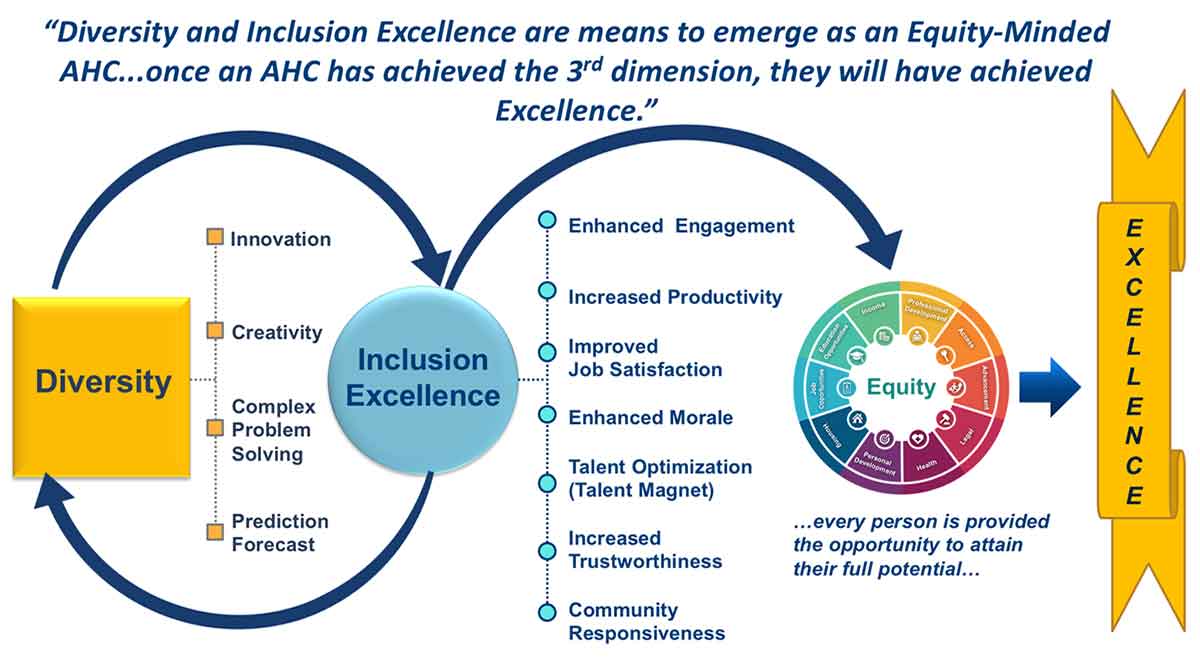Editor’s note: The opinions expressed by the author do not necessarily reflect the opinions of the AAMC or its members.
Despite more than a decade of work to actively recruit and retain a more diverse physician workforce, progress remains inequitable. While more women than men are now enrolled in medical school, black or African American, Hispanic or Latino, and American Indian or Alaska Native students represent just a fraction of the student body. In 2018, for instance, just 7.1% of matriculants to medical school identified as black or African American; 6.2% were of Hispanic, Latino, or Spanish origin; and 0.2% were American Indian or Alaska Native.
Likewise, medical school faculty continue to be predominantly white (63.9%) and male (58.6%), especially at the professor and associate professor ranks. Such disparities can have a dramatic impact not only on the culture and climate at academic medical centers but also on the ways in which we provide care for an increasingly diverse patient population.
In 2011, the AAMC encouraged academic medical institutions to embrace a framework for diversity that included removing social and legal barriers to diversity, intentionally integrating diversity into teaching, and embedding diversity into the core workings of the institution.
That hasn’t happened.
In fact, data suggests that persistent, structural racism and widespread implicit and explicit bias has created an exclusionary environment for many students and faculty. According to the 2018 AAMC Graduation Questionnaire, 42.1% of fourth-year medical students said that they personally experienced some form of mistreatment or harassment. This figure has changed little since 2014.
Indeed, it is becoming clear that the next generation of work for diversity and inclusion in academic medicine must include a deeper focus on changing the culture and climate of our learning and workplace environments — toward one that practices equity-mindedness and conscious inclusion.
Likewise, 63.4% of residents experience mistreatment and/or harassment — 66.6% of which was related to gender harassment. As a result, there is a significant incidence of poor emotional and mental health outcomes, which in turn have a direct impact on performance, patient care, and attrition. These findings are important because they are a direct reflection of our trainees’ “lived experiences” and ultimately represent the impact that institutional culture and climate have on our ability to attract and retain a more diverse workforce.
Indeed, it is becoming clear that the next generation of work for diversity and inclusion in academic medicine must include a deeper focus on changing the culture and climate of our learning and workplace environments — toward one that practices equity-mindedness and conscious inclusion.
Equity-minded learning and workplace environments
An equity-minded learning and workplace environment is achieved when every person in the
academic medical community — medical students, residents, fellows, faculty, and staff — has the opportunity to attain their full potential and no one is disadvantaged because of their social position or group identity (e.g. race, ethnicity, age, gender identity, sexual orientation, language, religion, physical/mental/developmental abilities).
This approach requires that an institution be deliberate in providing an intentional investment in their employees and learners so they can optimize their talents and achieve their full potential.
What does equity-mindedness look like in academic medicine?
It starts with five principles:
- Proactively educate ourselves (leaders and medical educators) about the historical context of exclusionary practices in higher education and other workplace settings and seek to recognize and understand the impact of this history on present-day institutional practices.
- Reject the ingrained habit of blaming inequities (and failures) on an individual student’s social, cultural, and educational background (e.g., MCAT® scores, GPA, the institution they attended) and change the focus inwardly to question our institutional effectiveness on student success.
- Recognize that the elimination of entrenched biases, stereotypes, and assumptions within the institution will require intentionality and the critical deconstruction of structures, governance, policies, practices, and embedded norms and values that are assumed to be race- and gender-neutral but actually sustain these inequities.
- Require system-based thinking to make the necessary transformative changes in our medical educational system and shift the paradigm from a screening out paradigm to one of investment. This will require us to also create a system that holds the institution and faculty accountable for student success and institutional effectiveness.
- Invest time, effort, and social and political capital and have the courage to begin having these discussions. Mobilize key internal and external stakeholders to partner in addressing the inequities and any exclusionary practices identified.
But increasing workforce diversity in numbers alone is not enough. Equally important is creating an environment that recognizes the value that differences bring to an organization, allows those differences to be expressed and practiced, and demonstrates the courage and the political and social will to ultimately leverage those differences to achieve the vision, mission, and goals of the organization. The ultimate goal is to ensure that people from all backgrounds are fully integrated, fully engaged, and fully empowered.
The ultimate goal is to ensure that people from all backgrounds are fully integrated, fully engaged, and fully empowered.
So where does an institution begin? It starts with a vision of what excellence looks like. The AAMC has developed a roadmap for practicing conscious inclusion and equity-mindedness called the Foundational Principles of Inclusion Excellence (FPIE) to assist medical schools in achieving inclusion excellence. The AAMC has also developed a number of culture/climate assessment tools, as well as tools to address an institution’s “pain spots” — mistreatment, harassment, abrasive behavior, racial tension, and gender inequities among them.
Diversity has been widely recognized as key to excellence in academic medicine. Practicing conscious inclusion and equity-mindedness to achieve inclusion excellence — an environment where diversity is a strategic imperative, inclusivity is intentional, and exclusionary practices have been identified, critically deconstructed, and eliminated — will enable the bonuses of diversity to be revealed, actualized, and leveraged.
Then and only then will a diverse workforce be empowered to attain its full potential — and academic medical centers be able to truly attain excellence.


